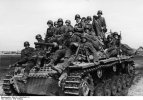Sorry to have got to this a bit late.
Nah, just 1 year and 2 months...

My understanding is that as well as trucks or halftracks and their passengers, the game needs to model different tactical doctrines. Below was gleaned from discussion on another game forum some years ago.
Correct. For instance, German halftracks didn't just transport or support infantry units, they also cooperated with tanks, often even closely. In these cases, the Panzergrenadiere dismounted when they had to tend stragglers, or when they had to help closing pockets. But say in Stalingrad and Charkov, it was the only way for the infantry to gain some ground (protected from small arms and MG fire, at least) and to have some additional firepower, when being mounted.
but the quantity of organic, readily at hand motorisation, was low compared to the German's motorised division.
I don't think that this is true.
A few elite units (this goes for SS, Army and Luftwaffe units) had the required strengths, which included the AFV and APC pool, at one or another point. Most of the other units either never reached the required levels, or they had to give units away, in order to maintain a minimum level of transportation/protection for other units that were (on paper) supposed to be motorized/mech units, too.
But the Western Allies had so many vehicles at their disposal, that they could use almost 6,000 trucks for their "Red Ball Express", employed between August and November 1944.
The Russians still had a general lack of transport vehicles, despite the US delivery of trucks under the lend-lease act, even in 1943. Some Russian units had to commence the attacks at the Chir river on foot, as there was no transportation available for them.
In turn, the Germans never established a car pool level that really matched the required strength unit levels on paper, this goes especially for halftracks. The Germans managed to fill their truck pool with captured french and Russian trucks - to some extent, and captured french halftracks (IIRC) were used too. Even though the truck pool was way bigger than the halftrack pool, the truck production output never reached the required level, either. Looking at the rough transport vehicle numbers of all sides, the Western Allies had a level of luxury going the Germans didn't even dare to dream of.
Only the FT mounting 251/16 would be appropriate for close quarters fighting. this sort of usage demands splitting a dismounted mot/mech unit into two or more units.
The 251 came in so many flavors, it also came with short-barreled inf guns, mortars, AT guns etc. etc., that it could actually be used in close combat, as well. Such halftracks were used in Stalingrad, during (and right next to) tank operations, in Kursk, and especially in Charkov, and also as assault vehicles for the dash across the Arnheim bridge (the Brits got that mix of armored recon cars and halftracks with their PIATs, IIRC).
I imagine that the destruction rate of these open top, lightly armored vehicles was not prohibitive because they were almost invariably at a greater distance from in range enemy than were other targets.
Actually, the loss rates were distinctively higher in SS units, as many of their commanders (those with less or no military education) tended to employ them almost like armored vehicles, means in a ruthless fashion, or they even had to employ them like that, due to the lack of tanks (during later stages of the several battles of Charkov, for example).
Since a) the pre-war and early war production output never reached the planned level and since the production of these vehicles involved quite some manual labor (limiting attempts to streamline the design) until 1943, the loss rate (mainly on the Russian front) was a serious nail in the mech forces' coffin, as such excessive losses could not be sustained.
will tend to target the closest visible threat rather than something, perhaps more valuable, but of less perceivable threat and further away. To simulate that might require units taking a check before targeting the non-closest enemy unit.
"Further away" and "less perceivable" are relative terms. The engine doesn't render historical view ranges, but historically, the Germans had superior view ranges (which came with the better clarity provided by their obs devices and gun periscopes). So, an armored or mechanized unit that can actually acquire, identify and engage meaty targets in the distance (say 1200 - 1400 meters), will not go for enemy infantry still crawling, straggling and searching for cover in front of them (say 800 meters away, outside their [inf] small arms range).
There's also the issue of AFV mounted infantry, of necessity pioneered by the Russians but, I believe, used by all sides at various points in the war.
The Russians didn't pioneer this.
If there was chance for a free a ride, a foot soldier never said "no", no matter what side he was fighting for. German grunts in spring 1942 :

